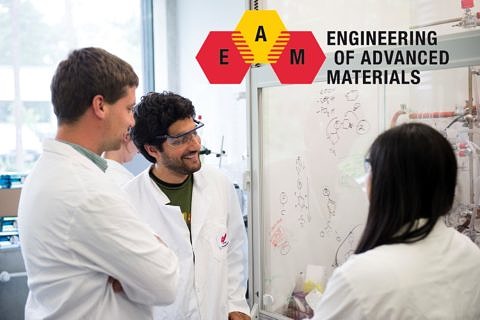EAM Starting Grant 2020
Funding of new research projects – four EAM Starting Grants awarded
A successful EAM tradition has been revived in 2020: With the award of the EAM Starting Grant, young FAU researchers were given the chance to pursue their own research projects and thus gaining a boost for a successful academic career. The grant is intended to bring new contributions and ideas into EAM’s research activities and aims at encouraging awardees to use the grant as seed funds for the preparation of new proposals.
This year, four awardees were chosen:
FORCED SURFACE DYNAMICS FOR NOVEL CATALYTIC CONCEPTS
Prof. Dr. Tanja Franken, 34
Junior Professor for Catalytic and Electrocatalytic Systems and Processes
at the Institute of Chemical Reaction Engineering
Exploiting the dynamic surface behavior of complex mixed metal oxides for future relevant thermo catalytic reactions
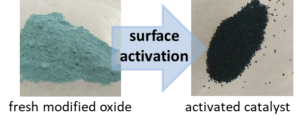
Avoiding the waste of energy, metals and other resources is one of the current central challenges to enable the transition to a sustainable future. In the chemical industry, sintering of catalysts significantly affects the efficiency and selectivity of processes. To overcome this issue completely new concepts need to be explored. The aim of the project is to design and stabilise highly active catalysts based on mixed metal oxides (MMOs), exploiting the dynamic behaviour of oxide surfaces near their stability limit. The activation of MMOs generates finely dispersed metal centres in close vicinity to important functional surface groups, which exhibit a high potential for high activity and selectivity in future relevant reactions for CO2 utilisation or for limiting of CH4 flaring. Examples are CO2 methanation, dry reforming of CH4 or water-gas shift reaction. The project will clarify how MMOs need to be modified in order to trigger surface dynamics and how the process needs to be operated in order to maintain highly active but transiently stable active centres. The fundamental understanding of the adaption of MMOs to generate and maintain high catalytic activity opens up completely new ways for catalyst synthesis and operation. This unconventional perspective on MMO surfaces forces a paradigm shift in the nature and capabilities of oxide based catalysts.
Contact: tanja.franken@fau.de
Webpage: https://www.crt.tf.fau.eu/forschung/arbeitsgruppen/catalytic-and-electrocatalytic-systems-and-processes/
DYNAMIC PROCESSES AT ATOMIC RESOLUTION
Dr. Andreas Hutzler, 32
Post-Doctoral Researcher at Electron Devices (LEB)
Modeling Electron-Beam Induced Radiolysis in Liquid-Phase Electron Microscopy – Radiochemistry in LP-EM
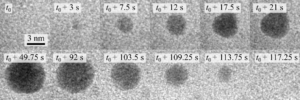
The objective of the project is to study the influence of the electron-beam interaction in liquid-phase electron microscopy (LP-EM) on the chemical environment of liquid specimen determining nucleation, growth, interaction and degradation of nanoparticulate systems. In order to study dynamic processes by direct observation on the nanoscale, LP-EM has been shown to be a powerful tool and an enrichment to complementary methods deploying X-ray or light scattering. For example, LP-EM was shown to be suitable for investigating the early stages of particle growth (see figure).
Although LP-EM opens up new possibilities of in situ characterization, the electron beam is known to severely influence or even trigger the observed phenomena and the environment in a liquid cell is often compared to the core of a nuclear reactor. Indeed, scientists try to prevent electron beam induced effects by using conductive membranes like graphene in combination with extremely low dose conditions like used in cryo EM. This, however, strongly limits the capabilities of modern electron microscopes in terms of temporal and spatial resolution. Furthermore, a deep understanding on the interaction of the electron beam with liquid specimen is needed in order to provide reliable predictions of non-biased processes apart from the artificial environment in LP-EM.
Hence, this project aims at verification, enhancement, and completion of existing kinetic models, which is a prerequisite for predicting chemical reactions in specimen solutions containing species beyond water. Accordingly, the results are subsequently utilized for the development of methods for measuring the actual concentrations of key species for enabling a verification of the proposed kinetic model. These studies are strongly needed for LP-EM becoming a standard characterization method in materials science, electrocatalysis and biology.
Contact: andreas.hutzler@fau.de
Webpage: https://www.leb.tf.fau.de/
NMR STUDIES OF CARBON NITRIDE MATERIALS FOR CO2 REDUCTION
Dr. Dorothea Wisser, 33
Post-Doctoral Researcher at Erlangen Center for Interface Research and Catalysis (ECRC)
Porous Carbon Nitride and Boron Carbon Nitrides – Correlation of Structure and Performance by Solid-State NMR
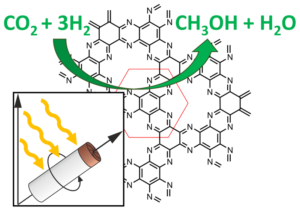
Carbon nitride and boron carbon nitride materials are promising new candidates for CO2 sequestration and photoreduction into methane, methanol or ethylene. The materials intrinsically contain micropores, and larger pores facilitating mass transport can be introduced during the preparation. In this project, solid-state nuclear magnetic resonance under Magic Angle Spinning (MAS NMR) will be employed to obtain an understanding of the material structures, defects and adsorption sites in molecular detail. The observation of CO2 adsorption and transformation in real time are crucial for understanding the process and for a targeted optimization of the materials, they are however challenging to implement. Therefore, in situ solid-state NMR investigation of the sorption and activation of CO2 in a continuous CO2 flow through the material will be established. For simulation of realistic industrial exhaust streams, conditions of water co-adsorption will be implemented by moist gas flows. Ultimately, light irradiation will be implemented to investigate the photoactivated CO2 reduction online under realistic reaction conditions.
Contact: dorothea.wisser@fau.de
Webpage: https://www.ecrc.fau.de/
SYNERGETIC ACTIVATION OF CO2
Moritz Wolf, Ph.D., 32
Head of Team at Helmholtz Institute Erlangen-Nürnberg for Renewable Energy (IEK-11), Forschungszentrum Jülich GmbH
Capturing synergetic effects of nitrides as carriers for catalytically active nanoparticles in situ
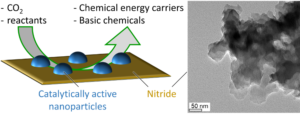
The project aims to identify and investigate potentially beneficial synergies when employing nitrides as support materials in heterogeneous catalysts. For example, carbon nitride as a carrier material for catalytically active nanoparticles has a great potential for efficient (co-)activation of CO2 and can therefore strongly influence the catalytic performance. Hence, bifunctional carbon nitride carrier materials may enable multiple conversion pathways for the valorisation of CO2 in addition to the physical support of the active phase. Even though inclusion of the green-house gas CO2 as feedstock in chemical sites is an important step towards a circular economy and sustainable production of basic chemicals, carbon nitride as a carrier material in heterogeneous catalysis has been barely explored. In fact, it is primarily employed as active photocatalyst and in electrocatalysis. Other nitrides have even been shown to have intrinsic catalytic activity and may offer further increased potential for the synergistic conversion of reactants. In the project, transition metal (oxide) based catalysts will be developed using this new class of carrier materials. The catalysts will be tested in several model reactions to identify various modes of synergy between the nitrides and the active phase. The advantageous effect of the nitrides on catalysis, when compared to classical carrier materials, may be evidenced by a boost in activity, selectivity and/or stability. Possible synergies of nitrides, such as the bifunctional activation of reactants, will mainly be investigated by means of in situ and operando characterisation techniques, which are becoming increasingly important in catalyst research. Such techniques enable the monitoring of certain catalyst properties under reaction conditions that are as close as possible to the actual conditions in commercial reactors, e.g. high temperatures and elevated operating pressures. The characterisation under such working conditions requires creative approaches for coupling the analysis of the catalysts with laboratory-scale reactor set-ups. However, this is the only way to study and understand the processes at play under reaction conditions, which is of utmost importance to draw conclusions on effective synergies between support material and catalytically active nanoparticles. The combination of sophisticated in situ techniques and innovative heterogeneous (model) catalysts may elucidate fundamental questions of catalysis addressing the role of the support material.
Contact: mo.wolf@fz-juelich.de
Webpage: www.hi-ern.de/hi-ern/h2Storage/EffHydroRelease
Twitter: www.twitter.com/Wolf_Catalysis
Note: This EAM Starting Grant project will be co-financed by the Helmholtz Institute Erlangen-Nürnberg for Renewable Energy (HI ERN, IEK-11).

